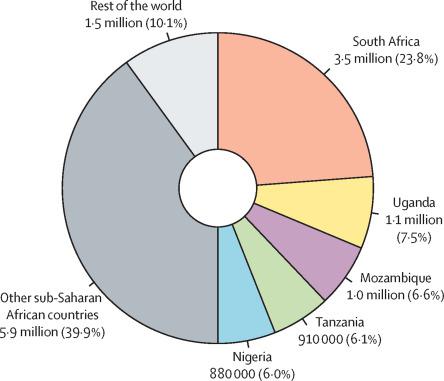The Lancet Global Health ( IF 34.3 ) Pub Date : 2019-11-29 , DOI: 10.1016/s2214-109x(19)30448-6 Amy L Slogrove 1 , Kathleen M Powis 2 , Leigh F Johnson 3 , John Stover 4 , Mary Mahy 5

|
Background
Children who are HIV-exposed uninfected (HEU) have higher morbidity and mortality than children who are HIV-unexposed and uninfected despite safer breastfeeding and improved maternal health with maternal antiretroviral therapy. We present the first global estimates of the population of children who are HEU (aged 0–14 years) and the geographical and temporal trends in HIV high-burden countries between 2000 and 2018.
Methods
The Spectrum AIDS Impact Module developed by Avenir Health, UNAIDS, and partners is used to estimate key HIV epidemic indicators from mathematical models. We used 2019 UNAIDS global estimates of children (aged 0–14 years) who are HEU generated by Spectrum and 2017 UN Population Division estimates of the number of all children in each region or country to estimate the regional or national prevalence of children who were HEU, the regional or national contribution of children who were HEU to the global population of children who were HEU, and the proportion of children who were HEU and exposed to antiretrovirals for six UNAIDS regions and 21 HIV high-burden countries in 2018. We also estimated the percentage change in the global population of children who were HEU between 2000 and 2018.
Findings
In 2018, there were an estimated 14·8 million (lower estimate 11·1–upper estimate 18·3) children who were HEU, 13·2 million (9·8–16·3; 90%) of whom resided in sub-Saharan Africa and 760 000 (640 000–970 000; 5%) of whom resided in the Asia and Pacific region. Five countries accounted for 50% of all 14·8 million children who were HEU globally: South Africa (3·5 million [23·8%]), Uganda (1·1 million [7·5%]), Mozambique (1·0 million [6·6%]), Tanzania (910 000 [6·1%]); and Nigeria (880 000 [6·0%]). In five southern African countries, the prevalence of children who were HEU exceeded 15% of the general child population: eSwatini (32·4%), Botswana (27·4%), South Africa (21·6%), Lesotho (21·1%), and Namibia (16·4%).
Interpretation
The global population of children who are HEU is substantial, requiring a coordinated strategy to reduce HIV exposure in children and ensure optimal health and wellbeing of children who are HEU and their families. Future research and programmatic funding investments must be aligned with the geographical distribution of children who are HEU.
Funding
National Institutes of Health, International AIDS Society.
中文翻译:

模型研究,2000-18年全球艾滋病毒感染者和未感染儿童的估计数。
背景
尽管母乳喂养更加安全,并且通过母体抗逆转录病毒疗法改善了母体健康,但未接触HIV的未感染儿童(HEU)的发病率和死亡率更高。我们提供了2000年至2018年间高致病性儿童(0-14岁)的儿童人数以及艾滋病高负担国家的地理和时间趋势的全球初步估计。
方法
由Avenir Health,UNAIDS和合作伙伴开发的“频谱AIDS影响模块”用于根据数学模型估算关键的HIV流行指标。我们使用了由Spectrum生成的2019年联合国艾滋病规划署对高致病性儿童的全球估计值(0-14岁)和2017年联合国人口司对每个地区或国家中所有儿童数量的估计数,以估计作为HEU的儿童的地区或国家患病率,2018年,六个联合国艾滋病规划署区域和21个艾滋病毒高负担国家的高致病性儿童在全球高致病性儿童中所占的区域或国家贡献,以及接受抗逆转录病毒药物的高致病性儿童的比例。我们还估算了在2000年至2018年之间,患有高浓铀的儿童在全球人口中所占的百分比变化。
发现
2018年,大约有14·800万名高中生儿童(下限为11·1名,最高估计数为18·3名),其中有13·200万名儿童(9·8-16·3名; 90%)居住在亚热带地区。 -撒哈拉以南非洲地区,其中76万(64万至97万; 5%)居住在亚洲及太平洋地区。五个国家占全球所有高等学校14·800万儿童的50%:南非(3·500万[23·8%]),乌干达(1·100万[7·5%]),莫桑比克(1 ·0百万[6·6%]),坦桑尼亚(91万[6·1%]);和尼日利亚(880 000 [6·0%])。在南部非洲的五个国家中,患有高浓铀的儿童患病率超过普通儿童总数的15%:eSwatini(32·4%),博茨瓦纳(27·4%),南非(21·6%),莱索托(21 ·1%)和纳米比亚(16·4%)。
解释
高致病性儿童的全球人口数量庞大,需要采取协调一致的战略,以减少儿童中的艾滋病毒暴露,并确保高致病性儿童及其家庭的最佳健康和福祉。未来的研究和计划性资金投资必须与HEU儿童的地理分布保持一致。
资金
国立卫生研究院,国际艾滋病学会。


























 京公网安备 11010802027423号
京公网安备 11010802027423号